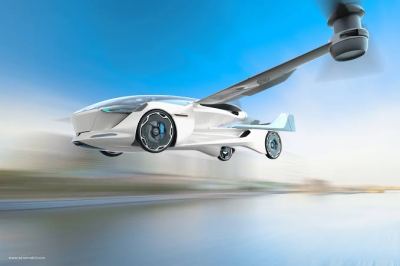“Asia’s First flying cars” would be used for transporting people and cargo, as well as for providing medical emergency services.
A few days ago, the Union Minister(Govt. of India) was introduced to the concept model of a flying car, developed by the young team of Vinata AeroMobility. Once this project takes off, it would be Asia’s First Hybrid flying car. Some of the benefits of this flying car include hassle-free commuting, entertainment onboard, full GPS Enabled, better visuals, luxurious feel, etc.
As per details available on the Vinata AeroMobility website, the following are some of the specifications of the Hybrid flying car:
Know about Flying Car-
- Type of Aircraft: Hybrid-electric VTOL (Passenger)
- The capacity of the flying car: Two passengers (one optional for pilot and passenger)
- Rotor Configuration: Co-axial quad-rotor
- Propeller: 8*Fixed pitch propellers
- Electric motors: 8*BLDC motors
- Power source: generators (biofuel)
- Canopy: Panoramic window canopy provided for 300-degree spectacular views
- Landing gear: Quadricycle landing gear
- Length including propeller: 5548 millimeter
- Breadth including propeller: 5477.53 millimeter
- Height: 2240 millimeter
- Maximum take-off weight: 1300 kg
- Empty weight: 990 kg
The flight time of this “flying car” is 60 minutes. It boasts a maximum speed of 120 km per hour.
The range is 100 kilometres and the service ceiling is 3,000 feet. The flying car also boasts Distributed Electric Propulsion (DEP), which provides safety through redundancy for its passengers.
Distributed Electric Propulsion means having various propellers as well as motors on the aircraft so in case one or more propellers or motors fail, the other working propellers and motors can land the aircraft safely. Besides, in the event of a generator power interruption, backup power provides electricity to the motor, says Vinata AeroMobility website.
Flying cars is a global phenomenon several companies and startups have been working on. It seems India is likely to witness the introduction of flying cars soon. Civil aviation minister Jyotiraditya Scindia has said that he met with a team from Vinata AeroMobility and checked a concept flying car.
It is expected to become Asia’s first hybrid flying car.
Scindia also said that once this concept model becomes reality, flying cars would be used for transporting people and cargo. Also, the flying cars would be used for providing medical emergency services.
What will do “Asia’s First “Flying Car ?
As the flying car manufacturer claims, once transformed into reality, this fully autonomous hybrid-electric VTOL vehicle will be capable of accomodating two passengers. It will be powered by a co-axial quad-rotor system that draws energy from eight BLDC motors that come with eight fixed pitch propellers. The vehicle will use biofuel for powering the motors.
This flying car can take off with a maximum weight of 1,300 kg. It can fly up to 60 minutes at a top speed of 120 kmph. In terms of range, the flying car can fly up to 100 km without refuelling. It can fly at a maximum height of 3,000 ft from ground level.
The manufacturer claims that in case one rotor of the flying car fails, other worker motors and propellers can safely land the aircraft.
With the city roads becoming increasingly congested, the sky could be a new route for commuting. Urban transportation experts have been advocating for such possibilities.
The flying cars can equally run on roads and fly in the sky. This would result in more convenience for the transportation sector with reduced time and lower congestion on roads as well. Even ride-sharing and ride-hailing platform like Uber has been mulling the idea of introducing flying car fleet for the future transport system.
Among the conventional auto giants, South Korean automaker Hyundai too has demonstrated such a concept where flying cars would be used for city commuting.
Other Notes:
Morgan Stanley has estimated the total addressable market for urban air mobility could hit $1 trillion by 2040 and $9 trillion by 2050.
In 2019, Hyundai, which has a dedicated Urban Air Mobility Division led by Jaiwon Shin, a former NASA engineer, pledged to invest about $1.5 billion in urban air mobility by 2025.
Read More- Flying bike coming soon

















